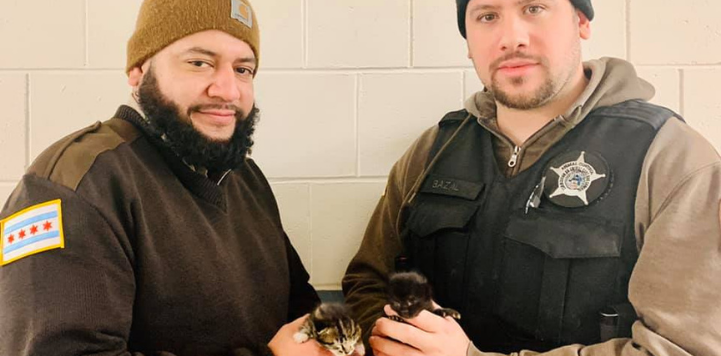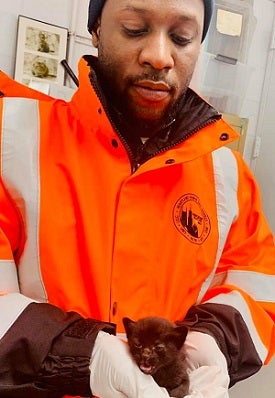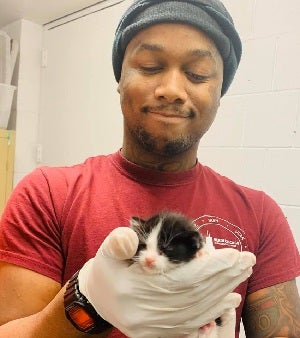
How to Build a Strong Partnership
We talk a lot about collaborative partnerships being the cornerstone of advancing animal welfare and increasing lifesaving. What does it take to build strong, fruitful partnerships in your community? Shared goals, transparency and a commitment to positive discourse are all key components, but it starts with leaders who are willing to lead by example.
When Jim Sweet transitioned from overseeing animal control to serving as executive director of Animal Services of Marion County, Florida, a little over two years ago, he was tasked with creating relationships in the community—something that was lacking when he stepped into the role.
“There were a few relationships between animal services and other animal welfare organizations, but they weren’t consistent, and they weren’t without drama,” he says.
Luckily, the new executive director of the Humane Society of Marion County (HSMC) was someone quite familiar to Jim: Eddie Leedy. Eddie stepped into the job three years ago following 34 years with the Marion County Sheriff’s Office.
In fact, the two worked together supportively for years, so it seemed a perfect place to start building a strong foundation. As directors of the two largest animal organizations in Marion County, Jim and Eddie also hoped taking the lead would inspire others to work more closely together. Slowly, Eddie says, that is what’s happening.
“We do have a couple organizations that are still reluctant to be team players, but they’ll get on board eventually,” Eddie says. “We all have the same common goal, after all. We love animals. So once we can show other groups that we aren’t there to steal their donors or resources, but in fact want to maximize the resources we each have to help pets, people are showing interest.”
Rally around Shared Goals, Ideals
Caring about and helping animals is a through line that exists no matter what community your shelter or rescues is in, and the best partnerships look at what their goals are to see how they can overlap with or complement those at other agencies.
“HSMC’s mission is to prevent the overpopulation of animals in Marion County, but we were only spaying and neutering shelter animals when I came on board,” Eddie says. “That wasn’t good enough to reach our goals for the community.”
HSMC developed relationships with TLC Pet Snip and Sheltering Hands and subsidizes public surgeries there monthly. Those partnerships have led to additional benefits, too. For instance, recently HSMC’s on-site clinic had a number of surgery appointments planned but one tech was off for the day and the other called in sick.
"I called our partner clinics and one of them sent a tech over to fill in for the day and help us,” Eddie says. “Likewise, when we had a very ill dog at our shelter this past weekend but couldn’t access any vets, Jim set me up with their shelter vet. And of course on light surgery weeks, we will call other groups in the area to fill the openings."
 Organizations can base their collaborations on shared ideals as well. “Save all the kittens in Long Beach, California” certainly isn’t the goal of Little Lion Foundation, but they are committed to saving the lives of as many kittens as possible. That ideal and their expertise positioned them perfectly to assist when SEAACA executive director Denise Woodside came knocking at their door. The Downey-based shelter system provides services for 14 cities in the region and is overwhelmed with kittens every year.
Organizations can base their collaborations on shared ideals as well. “Save all the kittens in Long Beach, California” certainly isn’t the goal of Little Lion Foundation, but they are committed to saving the lives of as many kittens as possible. That ideal and their expertise positioned them perfectly to assist when SEAACA executive director Denise Woodside came knocking at their door. The Downey-based shelter system provides services for 14 cities in the region and is overwhelmed with kittens every year.
“I was looking at our data and knew we could do a lot better for our cats and our community members,” says Denise. “When I learned about Little Lion, I told them who I was and what we were trying to do to move forward, they were in right away.”
“SEAACA takes in so many kittens from a large geographic area and they can’t possibly care for all of them,” LLF founder Claudia Otis says. “It’s been exciting for us to pull them into our nursery and save so many lives. I’m also excited because it’s sparking a new project on targeted TNVR. We know that’s where the kittens are coming from, so we are working hard to stop the flow in the first place through spay/neuter.”
Share in Your Successes
Partnerships usually are made up of a variety of small and large organizations, so make sure that it’s not just “the big guys” who are getting credit. Every organization involved in a rescue, a transport, a spay/neuter clinic, etc., deserves their due. The biggest groups also can leverage their name recognition to help the rest of their partners, too.
“Before we started working with Sheltering Hands, they weren’t operating at the level they wanted to for cats in the region because people didn’t know about them and weren’t bringing them animals,” Eddie says. “But after we started the Big Fix high-volume spay/neuter event and got the message out, they were overbooked.”
Likewise, don’t fall into the trap of saying your shelter “rescued” a dog from some tiny facility in a small town somewhere. That undermines the original shelter’s role in caring for that dog before he came into your hands and is dismissive of the hard work that staff is doing to try and save lives, too.
Eddie notes that they go to great lengths to make sure people identify all those groups partnering together on projects; in the case of the Big Fix, the name of each participating group is included on their new t-shirts.
“Every time I wear the shirt in public, I get asked by someone how they can be a part of it,” he says.
Ban Toxicity
Nothing can torpedo partnerships faster than in-fighting, jealousy and vicious personal attacks on social media. It’s one thing to avoid reacting to negative postings on your Facebook page (and if you don’t delete vitriolic chatter outright, at least don’t respond to it). Successful partnerships demand more proactive work to discouraging such activity in the first place.
"It’s easy to sit across town and blast someone, but it’s more difficult to do that face-to-face,” says Eddie. “We’ve found that doing joint operations like the Big Fix allows us to intertwine our employees. Putting names with faces helps them be accountable to one another the next time they are thinking about being a keyboard warrior."
Not all bashing on social media is coming from a bad place. Jim points out that this is an emotional business and people get caught up in the heat of the moment sometimes.
“I have no problem addressing people and asking them what’s going on that is making them post negative things,” Jim says. “It helps to talk through things because they often don’t have all the information. Our primary rule is no drama. I’m happy to work with anyone but I don’t take sides. It is not our place to judge our partners, and everyone has a place in this community.”
Before getting involved with SEAACA, Claudia says they hadn’t heard great things about the shelter system. But she and her fellow Little Lion volunteers work hard to always see things from the shelter’s perspective.
“I can’t even imagine how tough a job it is, running the shelter,” Claudia says. “It’s really not like they want to euthanize animals, but what do you do with 10,000 cats a year?”
The answer, of course, is you bring in others to help with lifesaving solutions.
“We love being able to save these kittens by working with SEAACA, and our organization is all about staying away from negative people so we can keep doing good work,” Claudia says. “If you are not helping the problem, you are causing the problem. If we can lighten the load at all, we are happy to do it.”
Look for Partners Outside our Industry
It’s easy to make a list of potential partners from the rescue groups, public and private shelters, dog trainers and vet clinics in any community. But don’t forget there are other agencies whose goals can complement what you are trying to achieve—and vice versa.
 “Municipal shelters don't always work in coordination with other departments in their municipality, and I think we do a really good job at that,” says Jenny Schlueter, public information officer, program manager and assistant to the director at Chicago Animal Care & Control (CACC). “Sometimes our animal control officers get called to scenes where they really want to help an animal, but they don’t have the tools to do so safely. For example, in the case of cats stuck in trees, equipment like cherry pickers or long ladders are necessary to do the job, and we don’t have them.
“Municipal shelters don't always work in coordination with other departments in their municipality, and I think we do a really good job at that,” says Jenny Schlueter, public information officer, program manager and assistant to the director at Chicago Animal Care & Control (CACC). “Sometimes our animal control officers get called to scenes where they really want to help an animal, but they don’t have the tools to do so safely. For example, in the case of cats stuck in trees, equipment like cherry pickers or long ladders are necessary to do the job, and we don’t have them.
“Other agencies do have this equipment, but they have limitations and priorities, too, which meant that sometimes they could help, but they could not always guarantee it. We finally sat down a few years ago and talked about ways to help those cats,” she continues.
“The main thing is to keep the dialogue going and problem-solve together, which we did. Now we have worked out arrangements and if the fire department is available to help us, they do. If they can't, the park district helps, or the department of forestry helps. We can always make something work.”
CACC also has several collaborative programs in place with other types of agencies in the city, like READI Chicago, a program run by social service agency Heartland Alliance that focuses on those residents of the community most at-risk for gun violence. Participants get counseling and on-the-job training at several types of businesses. At the shelter, they do everything from walking dogs to bottle-feeding kittens.
“Before we started, some of my colleagues had concerns about how it might work, but those guys have become indispensable here,” Jenny says. “Now my staff is always asking, ‘Hey, when are the READI guys in next? I have this project or that project for them to do!’”
CACC also has a job training partnership for parolees with the Westside Health Authority and several programs with Safe Humane Chicago. Participants in such programs can help plug the staffing gaps running so rampant these days in our industry.
“When your organization is just treading, there's not a lot of time to do anything beyond basic care,” she says. “These kinds of collaborations let us do so much more for animals and the community.”
Don’t be Afraid to Ask
Just as its easy to throw barbs at others from behind the safety of your computer screen, it’s easy to assume no one in your community is interested or able to help your organization. You’ll never know if that’s really true (and I highly doubt it is), however, if you don’t ask.
“I’m a firm believer that the good work we do brings people to us,” says Jim. “Our community is lucky because we have spay/neuter options, an animal-loving public and officials who support what we are doing. All the building blocks are here and it’s just about putting them together.”
Even if someone’s offer of assistance doesn’t fit neatly into one of your boxes—they can provide three specialty surgeries annually rather than the dozen per week you need—it can make a difference.
"Whether it be a partner who can commit to one piece of the work or hundreds, it all adds up,” Denise says. “I don’t think any group should doubt what contribution they may offer because it all helps."
“We are all in this together to solve a common problem by doing however much we can each do,” agrees Claudia. “And ultimately, there’s no room for competition because there are still too many animals who need our help.”

Liz Finch
Senior Writer
Best Friends Network
If you enjoyed this program spotlight, you can find our complete catalog of spotlights here.